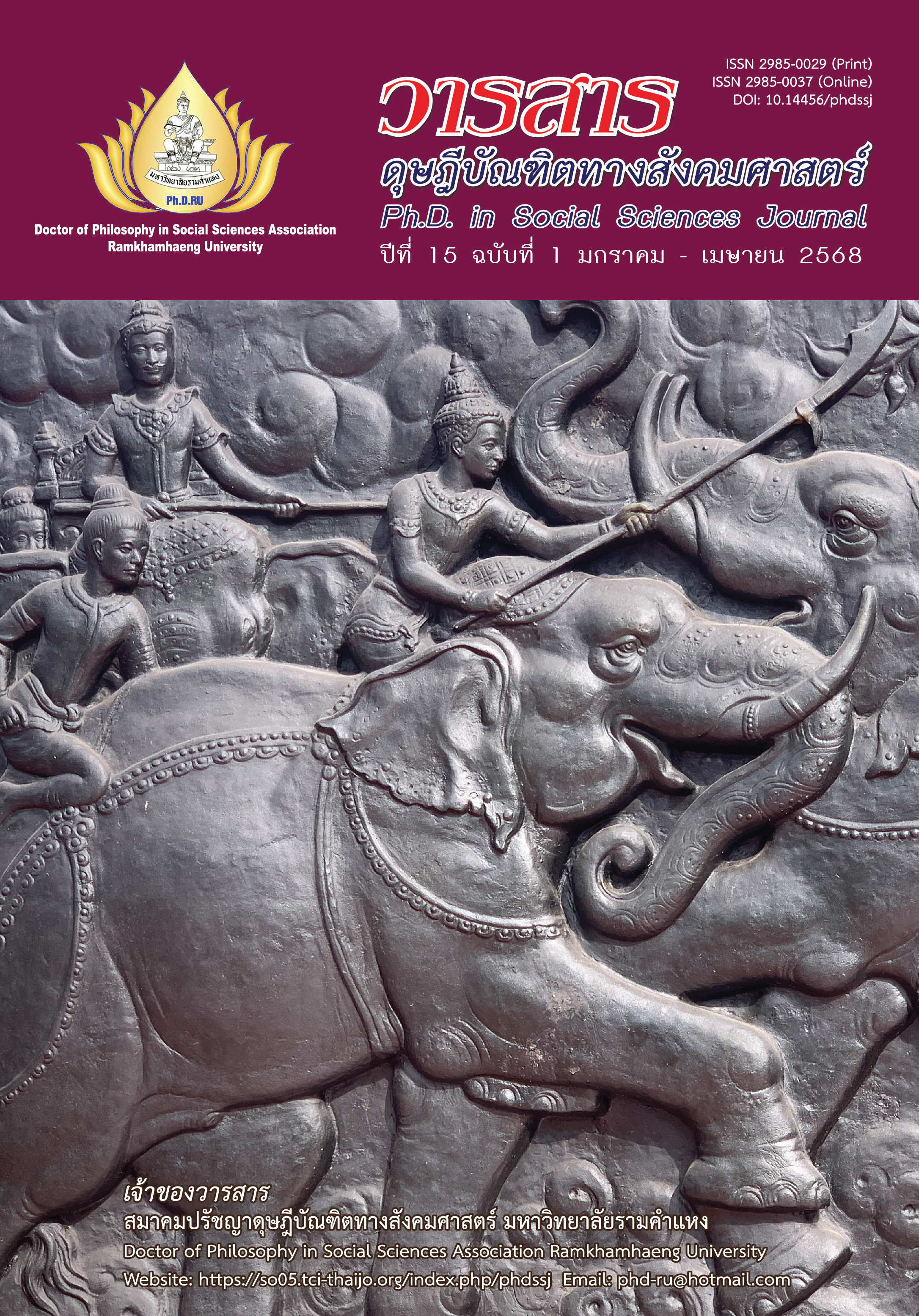อิทธิพลของปัจจัยด้านการรับรู้ของผู้ใช้ที่ส่งผลต่อความตั้งใจในการใช้งานนวัตกรรม ศูนย์ดิจิทัลเพื่อการท่องเที่ยวและบริการของประเทศไทย
Main Article Content
บทคัดย่อ
บทความวิจัยนี้มีวัตถุประสงค์เพื่อ (1) ศึกษาระดับของการรับรู้ประโยชน์ การรับรู้ความง่ายในการใช้งาน การรับรู้ความเสี่ยง การรับรู้ประสิทธิผลนโยบาย และความตั้งใจใช้งาน (2) ศึกษาอิทธิพลของการรับรู้ประโยชน์ การรับรู้ความง่ายในการใช้งาน การรับรู้ความเสี่ยง และการรับรู้ประสิทธิผลนโยบาย ต่อความตั้งใจใช้งาน และ (3) สร้างแบบจำลองปัจจัยที่ส่งผลต่อการยอมรับการใช้งานศูนย์ดิจิทัลเพื่อการท่องเที่ยวและบริการของประเทศไทย เป็นการวิจัยแบบผสานวิธี เก็บรวบรวมข้อมูลจากการวิจัยเอกสารโดยการสัมภาษณ์เชิงลึกและการอภิปรายกลุ่มสนทนาแบบเจาะจง ตัวอย่างเชิงปริมาณ คือ นักท่องเที่ยวทั้งชาวไทยและชาวต่างชาติที่เคยใช้บริการศูนย์ดิจิทัล จำนวน 500 คน ผู้ให้ข้อมูลหลักเลือกแบบเจาะจงจากกลุ่มข้าราชการในหน่วยงานภาครัฐ ผู้ประกอบการเอกชน และผู้เชี่ยวชาญด้านการจัดการเทคโนโลยีสารสนเทศและงานบริการ จํานวน 18 คน ทั้งนี้ เพื่อนํามาหาข้อสรุปด้วยการวิเคราะห์เนื้อหาและเสนอแนะอ้างอิงทฤษฎีดําเนินการจัดระเบียบข้อมูล และสถิติที่ใช้ในการวิเคราะห์ข้อมูลเชิงปริมาณ ได้แก่ ความถี่ ร้อยละ ค่าเฉลี่ย ส่วนเบี่ยงเบนมาตรฐาน การวิเคราะห์องค์ประกอบเชิงยืนยัน และโมเดลสมการโครงสร้าง
ผลการวิจัย พบว่า (1) การรับรู้ประโยชน์ การรับรู้ความง่ายในการใช้งาน การรับรู้ความเสี่ยง การรับรู้ประสิทธิผลนโยบาย และความตั้งใจใช้งานศูนย์ดิจิทัลอยู่ในระดับสูง (2) การรับรู้ประโยชน์ การรับรู้ความง่ายในการใช้งาน และการรับรู้ประสิทธิผลนโยบาย มีอิทธิพลเชิงบวกต่อความตั้งใจใช้งานศูนย์ดิจิทัล ในขณะที่การรับรู้ความเสี่ยงมีอิทธิพลเชิงลบต่อการรับรู้ประโยชน์และความตั้งใจใช้งานศูนย์ดิจิทัล และ (3) แบบจำลองปัจจัยที่ส่งผลต่อการยอมรับการใช้งานศูนย์ดิจิทัลเพื่อการท่องเที่ยวและบริการของประเทศไทย มีความสอดคล้องกับข้อมูลเชิงประจักษ์
Article Details

อนุญาตภายใต้เงื่อนไข Creative Commons Attribution-NonCommercial-NoDerivatives 4.0 International License.
บทความวิชาการ บทความวิจัย และบทวิจารณ์หนังสือในวารสารดุษฎีบัณฑิตทางสังคมศาสตร์ เป็นความคิดเห็นของผู้เขียน มิใช่ของคณะผู้จัดทำ และมิใช่ความรับผิดชอบของสมาคมปรัชญาดุษฎีบัณฑิตทางสังคมศาสตร์ มหาวิทยาลัยรามคำแหง (กรณีการทำวิจัยในมนุษย์ ผู้วิจัยต้องผ่านการอบรมจริยธรรมการวิจัยในมนุษย์ และนำหลักฐานมาแสดง)
เอกสารอ้างอิง
Agnes, E. (1999). Webster’s New World college dictionary (4th ed.). Wiley & Sons.
Ajzen, I. (1991). The theory of planned behavior. Organizational Behavior and Human Decision Processes, 50(2), 179-211.
Ajzen, I., & Fishbein, M. (1988). Theory of reasoned action-theory of planned behavior. University of South Florida, Tampa.
Alsmadi, D., Halawani, M., Prybutok, V., & Al-Smadi, R. (2022). Intention, trust and risks as core determinants of cloud computing usage behavior. Journal of Systems and Information Technology, 24(3), 178-201.
Bhatt, K. (2021). Adoption of online streaming services: Moderating role of personality traits. International Journal of Retail & Distribution Management, 50(4), 437-457.
Boonyoo, S., Suphaphattharaphisan, C., Boonmakerd, K., Boonthanon, S., & Boonyoo, T. (2022). Influence of technology acceptance and trust on the intention in using QR code payment system of consumers in Bangkok. Journal of Liberal Arts and Service Industry, 5(1), 45-56. [In Thai]
Chaisanit, S. (2012). Innovation and technology. Retrieved from https://settachai.wordpress.com/ 2012/08/13/นวัตกรรมและเทคโนโลยี [In Thai]
Comrey, A. L., & Lee, H. B. (1992). A first course in factor analysis (2nd ed.). Psychology Press.
Cronbach, L. J. (1984). Essentials of psychological testing (4th ed.). Harper & Row.
Davis, F. D. (1989). Technology Acceptance Model: TAM. In M. N. Al-Suqri & A. S. Al-Aufi (Eds.), Information seeking behavior and technology adoption (pp. 205-219). IGI Global.
Department of Tourism. (2022). Tourism service development plan 2023-2027. Author. [In Thai]
Hair, J., Black, W., Babin, B., Anderson, R., & Tatham, R. (2006). Multivariate data analysis (6th ed.). Pearson Prentice Hall.
Hiranphaet, A., Sooksai, T., Aunyawong, W., Poolsawad, K., Shaharudin, M. R., & Siliboon, R. (2022). Development of value chain by creating social media for disseminating marketing content to empower potential of participatory community-based tourism enterprises. International Journal of Mechanical Engineering, 7(5), 431-437.
Jhantasana, C., Munsawat, K., Maithomklang, S., & Chanchachot, A. (2017). Acceptance and usage of mobile phone for accessing to information of university using pls-sem case study of Faculty of Management Science of Valaya alongkorn Rajabhat University. RMUTT Global Business and Economics Review, 12(1), 161-176. [In Thai]
Likert, R. (1967). The human organization: Its management and values. McGraw-Hill.
Office of the National Tourism and Sports Policy Committee of Thailand. (2023). National Tourism Development Plan No. 3 (2023-2027). Author. [In Thai]
Office of the Secretary of National Addiction treatment & Rehabilitation Committee. (2022). Measures to prevent and control the outbreak of the coronavirus 2019. Retrieved from https://ncmc.moph.go.th/home/index/detail/29762 [In Thai]
Pallant, J. (2010). SPSS survival manual: A step by step guide to data analysis using the SPSS program (4th ed.). McGraw-Hill.
Rogers, E. M. (2002). Diffusion of preventive innovations. Addictive Behaviors, 27(6), 989-993.
Rubin, H. J., & Rubin, I. S. (2012). Qualitative interviewing: The Art of Hearing Data (3rd ed.). Sage.
Thailand Tourism Directory. (2021). Data management performance report. Retrieved form https://www.thailandtourismdirectory.go.th [In Thai]


